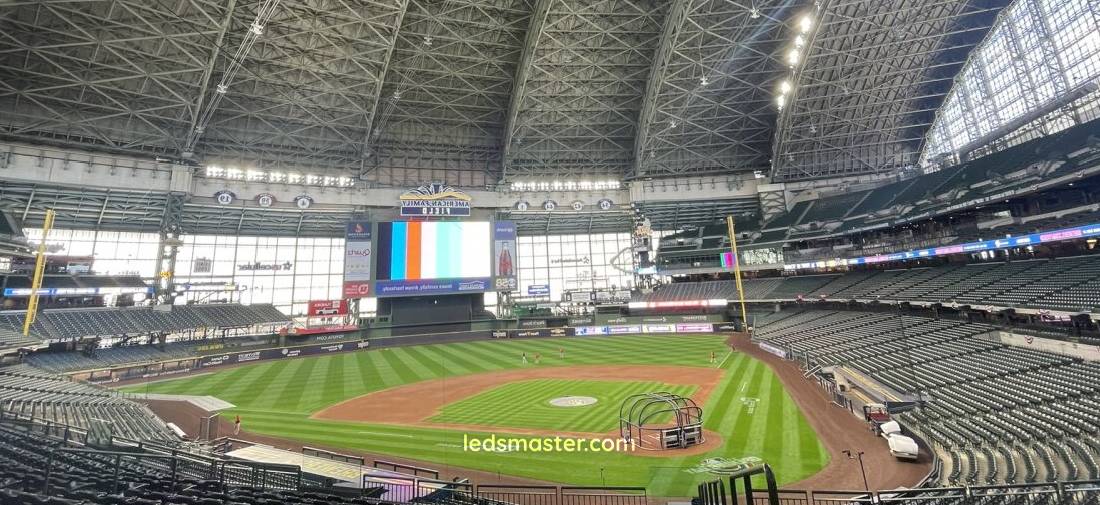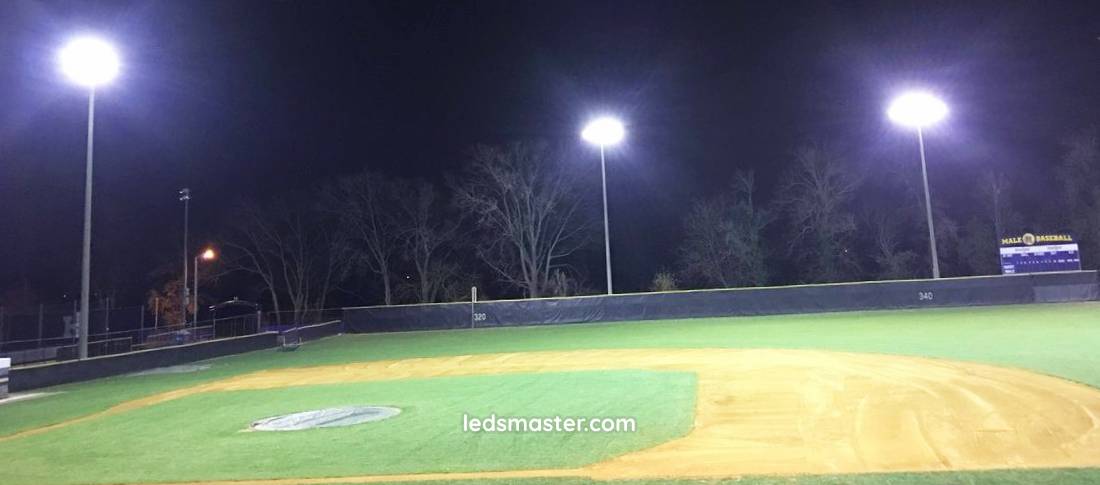
Ensuring peak performance and longevity of your baseball field lighting system maintain optimal visibility and safety during games and events. Our dedicated team of experts specializes in the meticulous maintenance of baseball field lighting, ensuring top-notch efficiency and extended lifespan of your system. Learn how our professional maintenance services can elevate your field’s lighting standards.
Get your complimentary lighting design today
Maintaining optimal lighting color on a baseball field is not only for visibility and player performance but also for creating a vibrant and engaging atmosphere for fans. Effective maintenance practices ensure that the field’s lighting system remains consistent and reliable, enhancing the overall experience of the game.
In this article, we delve into the key aspects of maintaining baseball field lighting color. From frequency of checks to strategic long-term planning, each section provides insights into how facilities can uphold lighting standards that meet the demands of competitive sports and enhance the aesthetic appeal of the venue. Discover the essential practices that contribute to sustaining vibrant and uniform lighting, ensuring every game is played under ideal conditions for players and spectators alike.
Table of Contents
ToggleTo uphold consistent lighting color, maintenance checks should be conducted regularly throughout the year. It is recommended to schedule inspections quarterly, with more thorough assessments biannually during offseason periods. This timing allows for comprehensive evaluation and adjustment of the lighting system without disrupting scheduled games or practices.
Regular maintenance not only ensures that the lighting meets performance standards but also addresses any potential issues proactively, reducing the likelihood of unexpected failures during critical game times. This proactive approach not only enhances player visibility and safety but also contributes to the overall efficiency and longevity of the lighting infrastructure, minimizing operational costs and maximizing the enjoyment of baseball events for all stakeholders involved.

During maintenance sessions, various components and systems must undergo thorough inspection and evaluation to ensure that the lighting system is functioning at its best. A primary focus involves assessing the condition of light fixtures and lenses. These components must be kept clean and free from debris that could obstruct light distribution or affect color fidelity. Accumulations of dirt, grime, or other obstructions can severely impact the quality of light emitted from fixtures, leading to uneven illumination and color variations on the field.
Special attention should be directed toward high-traffic zones, particularly the outfield and the bases. These areas experience the highest demand for lighting due to the constant activity associated with gameplay. Evaluating the condition of fixtures in these locations ensures that they continue to provide adequate illumination for safe gameplay. The effectiveness of lighting in these zones is critical, as any deficiencies can lead to safety concerns for players attempting to catch a fly ball or make a play at a base.
Another aspect of the inspection process is assessing the structural integrity of the poles and supports that hold the lighting fixtures. Any potential damage to these structures could compromise the alignment and overall performance of the lighting system. Regular checks help identify any signs of wear, rust, or instability that could lead to more significant issues down the line. Addressing these concerns proactively can prevent costly repairs and ensure that the lighting system remains both safe and effective throughout the season.
Facilities should assess for any new obstructions or changes that could impact lighting quality. Factors such as overgrown vegetation, new buildings, or changes in landscaping can all affect how light is distributed across the field. By identifying and addressing these environmental changes during maintenance sessions, facilities can maintain optimal lighting conditions. Consistent lighting not only enhances visibility for players but also ensures a better viewing experience for spectators, thereby contributing to the overall enjoyment of baseball games.
Guidelines surrounding lamp replacement maintain consistent lighting color and overall performance. Instead of waiting for lamps to fail completely, facilities should adopt a proactive approach to lamp replacement. This strategy involves replacing lamps based on their rated lifespan and performance degradation. By anticipating when a lamp is likely to fail and replacing it in advance, facilities can mitigate the risk of color variations and ensure uniform illumination across the field.
Uniform lighting is fundamental for player visibility, particularly during moments of gameplay. The clarity of visual details, such as the ball’s trajectory or player movements, directly impacts the quality of the game. Selecting lamps that meet or exceed recommended color rendering index (CRI) standards enhances this clarity. A high CRI ensures that colors appear true and vibrant under the lights, which is essential for maintaining the aesthetic quality of the game and supporting fair play.
Moreover, consistent lamp replacement not only preserves the quality of lighting but also contributes to the safety of players and officials. Inadequate lighting conditions can lead to injuries or mistakes during gameplay, making it imperative for facilities to uphold high standards in their lighting systems. By adhering to lamp replacement guidelines, facilities can ensure that their lighting systems operate optimally, providing a safe and enjoyable environment for everyone involved.
The integrity of the electrical system is another component of maintaining reliable lighting color and performance. Regular checks on the electrical system are vital to ensuring that all components, including wiring, connectors, and control mechanisms, function correctly. Faults in these elements can lead to issues such as voltage fluctuations or intermittent lighting, which can significantly disrupt games and events. Promptly addressing electrical anomalies is key to maintaining stable illumination levels and preventing disruptions that could detract from the overall experience for players and spectators.
In addition to routine inspections, investing in advanced monitoring systems can provide real-time insights into the performance of the electrical system. These systems are designed to detect anomalies early, enabling facilities to perform timely maintenance and minimize downtime. For example, smart monitoring systems can alert maintenance personnel to fluctuations in power or malfunctions in the lighting fixtures. By allowing for quick intervention, these systems help prevent issues from escalating into larger problems that could impact game play.
Moreover, a robust electrical infrastructure is foundational to ensuring consistent and dependable lighting throughout the baseball season. Investing in a reliable electrical system pays dividends in terms of overall reliability and performance, ultimately enhancing the experience for athletes, officials, and spectators. Facilities that prioritize electrical system integrity can be confident that their lighting will perform optimally, contributing to a seamless and enjoyable atmosphere during events.
Achieving optimal lighting alignment enhance color consistency and visibility on the field. During maintenance sessions, meticulous adjustments of fixture positions are necessary to optimize light distribution and minimize glare. Adjusting the angles and positions of lighting fixtures ensures that light is directed precisely where it is needed while preventing harsh shadows or overly bright spots that can distract players and officials.
Each area of the field has specific lighting requirements based on its function and the nature of gameplay. For instance, the pitcher’s mound and the bases may require different illumination levels compared to the outfield. By aligning lighting fixtures to meet these distinct requirements, facilities can ensure uniformity and comfort for players, contributing to a more enjoyable and competitive atmosphere.
The use of lighting simulation tools can greatly enhance the ability to predict and optimize light distribution across the field. These advanced tools allow facility managers to visualize how light will interact with the field layout and make informed decisions regarding fixture placement and alignment. This proactive approach can help ensure that every area receives adequate illumination for both daytime and nighttime games, significantly improving playability and safety for all participants.
Furthermore, regularly reviewing and adjusting lighting angles based on seasonal changes in daylight maintain performance throughout the year. As seasons change, so do the angles of natural light, which can affect how artificial lighting is perceived. By making periodic adjustments to account for these changes, facilities can uphold optimal lighting conditions, thereby enhancing the overall quality of play and spectator experience.
A comprehensive maintenance strategy encompasses all aspects of lighting upkeep, including inspections, lamp replacement, electrical checks, and alignment adjustments. This multifaceted approach ensures that no element is overlooked, allowing facilities to remain prepared for the challenges posed by the baseball season. Establishing a detailed maintenance schedule is crucial for keeping track of inspections and repairs.
For example, quarterly maintenance checks could focus on visual inspections and cleaning of fixtures, while biannual assessments might involve more in-depth evaluations of the entire lighting system, including electrical components. By clearly delineating the responsibilities of each maintenance session, facilities can ensure they address all necessary areas without redundancy, maximizing the efficiency of the maintenance process.
Proper documentation of maintenance activities track the condition of the lighting system over time. This documentation should include records of inspections, repairs, lamp replacements, and any adjustments made to the system. By maintaining a comprehensive log, facilities can identify trends, track performance, and plan for future upgrades or replacements. This information is invaluable for making informed decisions about budgeting and resource allocation for lighting maintenance.
Ensuring that staff members are well-versed in the latest technologies and maintenance techniques can lead to improved efficiency and effectiveness. Regular training sessions can also help personnel stay informed about industry advancements, enabling them to implement innovative solutions for lighting challenges.
Facilities should also remain open to feedback from players and spectators regarding lighting quality. Engaging with stakeholders can provide valuable insights into the effectiveness of the lighting system and highlight areas for improvement. By fostering a collaborative atmosphere, facilities can continuously enhance the quality of their lighting and overall experience for everyone involved in baseball activities.

Effective long-term maintenance planning goes beyond routine checks; it involves strategic foresight to enhance system longevity and efficiency. Incorporate periodic reviews of lighting design to leverage advancements in technology and energy efficiency standards. Plan for future upgrades or retrofits that align with evolving sporting regulations and environmental sustainability goals, ensuring the field remains well-lit and compliant for years to come.
Evaluate integrating smart lighting solutions that offer remote monitoring and automated maintenance alerts, allowing for proactive adjustments and energy savings. Collaborate with lighting experts and manufacturers to stay abreast of emerging trends and innovations, ensuring that your facility remains at the forefront of lighting technology. By embracing long-term planning strategies, facilities can maximize the return on investment in their lighting systems while maintaining high standards of performance and sustainability.
Meticulous maintenance of baseball field lighting color not only upholds aesthetic appeal but also elevates safety and performance standards for athletes and spectators alike. By adhering to comprehensive inspection protocols, addressing critical maintenance areas, and embracing long-term sustainability practices, facilities can sustain vibrant, consistent lighting that meets the evolving demands of modern sports environments.